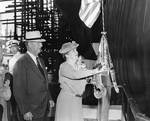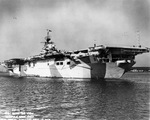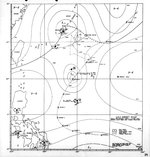Hornet (Essex-class)
| Country | United States |
| Ship Class | Essex-Class Aircraft Carrier |
| Builder | Newport News Shipbuilding |
| Laid Down Date | 3 Aug 1942 |
| Launch Date | 30 Aug 1943 |
| Commission Date | 29 Nov 1943 |
| Decommission Date | 15 Jan 1947 |
| Displacement | 27,100 tons standard; 36,380 tons full |
| Length | 872 feet |
| Beam | 147 feet |
| Draft | 34 feet |
| Machinery | 8 boilers, 4 Westinghouse geared steam turbines, 4 shafts |
| Bunkerage | 6,330t fuel oil; 240,000gal aviation fuel |
| Power Output | 150,000 shaft horsepower |
| Speed | 33 knots |
| Range | 20,000nm at 15 knots |
| Crew | 2,600 |
| Armament | 4x twin 5in, 4x5in, 8x quad 40mm, 46x20mm |
| Armor | 2.5in to 4in belt, 1.5in hangar, 4in bulkheads, 1.5in STS top and sides of pilot house, 2.5in top of |
| Aircraft | 90 |
| Elevator | 3 (1 deck edge, 2 centerline) |
Contributor: C. Peter Chen
ww2dbaseOriginally named Kearsarge, the ship was renamed Hornet in honor of the carrier Hornet that was lost during the Solomons Campaign in Oct 1942. Her shakedown training took place off Bermuda. On 14 Feb 1944 she sailed from Norfolk, VA to join the Fast Carrier Task Force in the Marshalls. Her aircraft supported the invasion on New Guinea, bombarded Japanese bases in the Caroline Islands, and supported the landings on the Marianas Islands by striking Japanese bases on Iwo Jima and Chichi Jima on 15-16 Jun 1944 to prevent their aircraft from reinforcing the Marianas. On 18 Jun, Hornet participated in the Battle of the Philippine Sea, as known to the Americans as the Great Marianas Turkey Shoot. After raids on Japanese bases on Guam, Bonin, the Palau Islands, Okinawa, and Taiwan, she then supported the landings on Leyte, Philippines on 20 Oct 1944, and participated in the Battle off Samar by supporting the overwhelmed American fleet with air support. Near the end of the war, Hornet's aircraft raided the Japanese home islands and supporting the landings on Iwo Jima and Okinawa.
ww2dbaseAs a carrier operating near Japan, Hornet was a prime target for whatever air power Japan had left. During the last 16 months of the war, she sustained 59 air attacks. However, her pilots had much to show for as well. During this time her pilots destroyed 1,410 Japanese aircraft and sank 1,269,710 tons worth of Japanese shipping.
ww2dbaseAfter the war, Hornet participated in Operation Magic Carpet that brought American service men back to the United States. She returned to San Francisco on 9 Feb 1946 and became decommissioned there in Jan 1947. She was recommissioned in 1951 for tension with Communist expansion in China and remained generally in the Pacific area on a wide array of missions, including the recovery of manned and unmanned spaceships of the Apollo program. She was decommissioned in 1970 and became a museum ship in 1998 at the former Alameda Naval Air Station in Alameda, California, United States.
ww2dbaseSource: Wikipedia.
Last Major Revision: Mar 2006
Aircraft Carrier Hornet (Essex-class) Interactive Map
Photographs
 |  |
Maps
 |
Videos
 |
Hornet (Essex-class) Operational Timeline
| 29 Nov 1943 | USS Hornet was commissioned into service at the Norfolk Navy Yard, Portsmouth, Virginia with Miles Browning in command. |
| 29 May 1944 | William Sample became the commanding officer of USS Hornet, relieving Miles Browning. |
| 20 Jun 1944 | At 1130 hours, the Japanese Mobile Fleet, withdrawing west from the losses sustained on the previous day during the Battle of the Philippine Sea, paused to refuel from tankers while Vice Admiral Jisaburo Ozawa transferred his flag aboard Zuikaku. At 1500 hours, cruiser Atago reported seeing an American scout plane, and Ozawa ordered the refueling to be stopped and the fleet was to sail to the northwest at the speed of 24 knots. At 1725 hours, a large incoming American strike was detected. The Japanese mustered 17 fighters for defense, while the Haguro, Myoko, Yahagi, and seven destroyers formed a tight circle around Zuikaku. 95 American fighters, 54 torpedo bombers (most of which were armed with bombs rather than torpedoes), and 77 dive bombers from USS Hornet, USS Yorktown, and USS Belleau Wood arrived at 1730 hours, hitting Zuikaku once with a bomb, causing some damage. |
| 13 Jul 1944 | USS Hornet spent the day conducting refueling operations. |
| 9 Aug 1944 | Austin Doyle became the commanding officer of USS Hornet, relieving William Sample. |
| 13 Oct 1944 | USS Hornet launched a reconnaissance mission over the Japanese Navy seaplane base at Toko Bay (now Dapeng Bay), southern Taiwan. |
| 18 Dec 1944 | Many ships from the United States Third Fleet, Task Force 38 sailed into Typhoon Cobra in the Philippine Sea. Three destroyers and 790 men were lost. |
| 4 Jun 1945 | Many ships from the United States Third Fleet, primarily Task Groups 38.1 and 30.8 sailed into Typhoon Connie south of Japan. No ships were lost but 7 men lost their lives. |
| 1 Aug 1945 | Charles Brown became the commanding officer of USS Hornet, relieving Austin Doyle. |
| 14 Feb 1946 | Charles Coe became the commanding officer of USS Hornet, relieving Charles Brown. |
| 14 Aug 1946 | Charles Coe stepped down as the commanding officer of USS Hornet. |
| 15 Jan 1947 | Hornet (Essex-class) was decommissioned from service. |
| 20 Mar 1951 | Francis Busey became the commanding officer of USS Hornet. |
| 30 Apr 1951 | Gorman Merrick became the commanding officer of USS Hornet, relieving Francis Busey. |
| 12 May 1951 | Gorman Merrick stepped down as the commanding officer of USS Hornet. |
| 11 Sep 1953 | Milton Adolphus became the commanding officer of USS Hornet. |
| 19 Jul 1954 | Frank Brandley became the commanding officer of USS Hornet, relieving Milton Adolphus. |
| 20 Jul 1955 | Norwood Campbell became the commanding officer of USS Hornet, relieving Frank Brandley. |
| 18 Aug 1956 | William Hollister became the commanding officer of USS Hornet, relieving Norwood Campbell. |
| 12 Aug 1957 | Thomas Connolly became the commanding officer of USS Hornet, relieving William Hollister. |
| 25 Aug 1958 | Marshall White became the commanding officer of USS Hornet, relieving Thomas Connolly. |
| 20 Nov 1959 | Ernest Christensen became the commanding officer of USS Hornet, relieving Marshall White. |
| 2 Nov 1960 | David Richardson became the commanding officer of USS Hornet, relieving Ernest Christensen. |
| 18 Oct 1961 | Hoyt Mann became the commanding officer of USS Hornet, relieving David Richardson. |
| 24 Sep 1962 | Ellis Fisher became the commanding officer of USS Hornet, relieving Hoyt Mann. |
| 25 Sep 1963 | John Hardy became the commanding officer of USS Hornet, relieving Ellis Fisher. |
| 15 Jul 1964 | Mayo Hadden, Jr. became the commanding officer of USS Hornet, relieving John Hardy. |
| 1 Jul 1965 | William Pardee became the commanding officer of USS Hornet, relieving Mayo Hadden, Jr. |
| 1 Apr 1966 | Van Eason, Jr. became the commanding officer of USS Hornet, relieving William Pardee. |
| 27 Feb 1967 | Gordon Robertson became the commanding officer of USS Hornet, relieving Van Eason, Jr. |
| 23 Feb 1968 | Jackson Stockton became the commanding officer of USS Hornet, relieving Gordon Robertson. |
| 23 May 1969 | Carl Seiberlich became the commanding officer of USS Hornet, relieving Jackson Stockton. |
| 26 Jun 1970 | USS Hornet was decommissioned from service. |
| 25 Jul 1989 | USS Hornet was struck from the US Naval Vessel Register. |
| 26 May 1998 | USS Hornet was donated to the Aircraft Carrier Hornet Foundation. |
| 17 Oct 1998 | USS Hornet was opened to the public as USS Hornet Museum in Alameda, California, United States. |
Please consider supporting us on Patreon. Even $1 per month will go a long way! Thank you. Please help us spread the word: Stay updated with WW2DB: |

» Browning, Miles
» J. J. Clark
Event(s) Participated:
» New Guinea-Papua Campaign, Phase 3
» Mariana Islands Campaign
» Philippines Campaign, Phase 1, the Leyte Campaign
» Typhoon Cobra
» Raid into the South China Sea
» Battle of Iwo Jima
» Okinawa Campaign
» Typhoon Connie
» Preparations for Invasion of Japan
 |  |
- » 1,181 biographies
- » 337 events
- » 45,115 timeline entries
- » 1,248 ships
- » 350 aircraft models
- » 207 vehicle models
- » 376 weapon models
- » 123 historical documents
- » 261 facilities
- » 470 book reviews
- » 28,411 photos
- » 365 maps
Winston Churchill, 1935